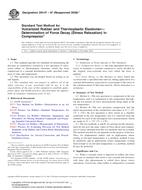Potřebujeme váš souhlas k využití jednotlivých dat, aby se vám mimo jiné mohly ukazovat informace týkající se vašich zájmů. Souhlas udělíte kliknutím na tlačítko „OK“.
ASTM D6147-97(2008)e1
Standard Test Method for Vulcanized Rubber and Thermoplastic Elastomer´Determination of Force Decay (Stress Relaxation) in Compression (Includes all amendments And changes 12/19/2014).
Automaticky přeložený název:
Standardní zkušební metoda pro vulkanizovaného kaučuku a termoplastické Elastomer'Determination Force Decay ( relaxace napětí v tlaku )
NORMA vydána dne 1.1.2008
Informace o normě:
Označení normy: ASTM D6147-97(2008)e1
Poznámka: NEPLATNÁ
Datum vydání normy: 1.1.2008
Kód zboží: NS-34003
Počet stran: 7
Přibližná hmotnost: 21 g (0.05 liber)
Země: Americká technická norma
Kategorie: Technické normy ASTM
Anotace textu normy ASTM D6147-97(2008)e1 :
Keywords:
compressive stress relaxation, force decay, force relaxation, force retention, load decay, reaction force, rubber, stress decay, stress relaxation, thermoplastic elastomer, Vulcanized rubbers, Compression testing--rubber, Force decay, Stress relaxation tests, Thermoplastic elastomers, ICS Number Code 83.140.99 (Other rubber and plastic products)
Doplňující informace
| Significance and Use | ||||||||||||
|
When a constant strain is imposed on rubber, the force necessary to maintain that strain is not constant but decreases with time; this phenomenon is called force decay (stress relaxation). Conversely, when rubber is subjected to a constant stress, an increase in the deformation takes place in time; this behavior is called creep. These phenomena are of practical significance in rubber articles, such as seals and gaskets. The processes responsible for force decay may be either physical or chemical in nature, and under all normal conditions both processes will occur simultaneously. However, at ambient or low temperatures and/or short times, force decay is dominated by physical processes, while at elevated temperatures and/or long times, chemical processes are dominant. Hence, it is neither safe to extrapolate time/force decay curves in order to predict force decay after periods considerably longer than those covered by the test, nor to use tests at higher temperatures as accelerated tests to give information on force decay at lower temperatures. In addition to the need to specify the temperature and time-intervals in a force decay test, it is also necessary to specify the initial stress and the previous mechanical history of the test specimen, since these may also influence the measured force decay, particularly in rubbers containing fillers. |
||||||||||||
| 1. Scope | ||||||||||||
|
1.1 This standard specifies two methods for determining the decrease in counterforce exerted by a test specimen of vulcanized rubber or thermoplastic elastomer which has been compressed at a constant deformation under specified conditions of time and temperature. 1.2 This document was developed based on testing in air and liquids. 1.3 This standard does not purport to address all of the safety concerns, if any, associated with its use. It is the responsibility of the user of this standard to establish appropriate safety and health practices and determine the applicability of regulatory limitations prior to use. |
||||||||||||
| 2. Referenced Documents | ||||||||||||
|
Doporučujeme:
Aktualizace technických norem
Chcete mít jistotu, že používáte pouze platné technické normy?
Nabízíme Vám řešení, které Vám zajistí měsíční přehled o aktuálnosti norem, které používáte.
Chcete vědět více informací? Podívejte se na tuto stránku.




 Cookies
Cookies
